Are The Disney Animated Movies Of The Late '90s Any Good?
(Welcome to Nostalgia Bomb, a series where we take a look back on beloved childhood favorites and discern whether or not they're actually any good. In this edition: a look back at Disney's post-rennaisance animated output, including The Hunchback of Notre Dame, Mulan, and Hercules.)When people think of Disney, they often jump to the classics – Bambi, Dumbo, Snow White, and so on. But my generation has a different list. We were raised on the studio's late '80s and early '90s "renaissance" titles, including Beauty and the Beast, The Little Mermaid, Aladdin, and The Lion King. But after 1995, the seemingly unstoppable Disney animation machine began to slow down. The films of the late '90s live on as childhood favorites, not undisputed classics.And that brings me to the question of the moment: some 20 years later, do these later films of the renaissance era hold up? Are their charms enough to cover their bigger flaws? Is it all nostalgia or are some of these true cinematic gems? Please keep your arms, feet and legs inside the vehicle at all times, because we're about to take a trip to the late-'90s era of the House of Mouse.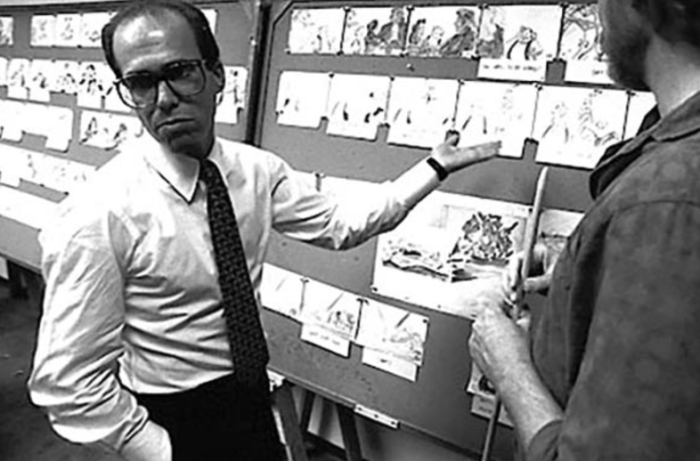
A Post-Katzenberg World
After the incredible success of The Lion King, Jeffrey Katzenberg, the chairman of Walt Disney Studios, stepped down. Why would one of the main guy's responsible for Disney's resurgence into popularity want to jump ship? As with many Hollywood stories, too many egos (including those of Michael Eisner and Roy E. Disney) were a big part of it, along with lots and lots of money (which led to a massive lawsuit in the years ahead). If you've seen the documentary Waking Sleeping Beauty, you probably know the finer details of this drama. Here is where the film that followed The Lion King comes into view. In fact, this was the project that Katzenberg and the other studio heads thought was a sure winner of Disney's line-up. It was pitched as being Romeo and Juliet meets Dances with Wolves, and that the Lion picture was experimental at best. Of course, the end results tell a very different story.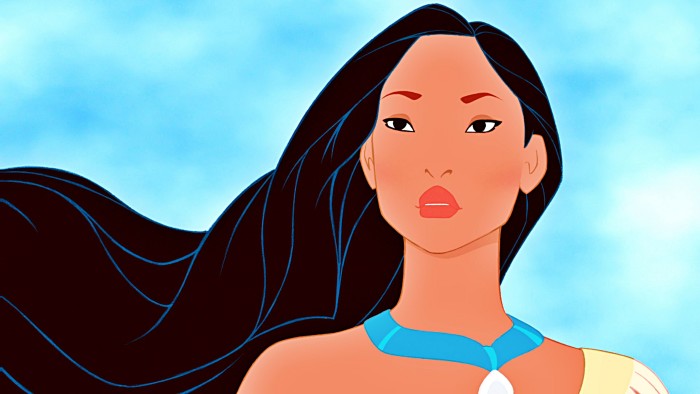
Best Song: “Colors of the Wind”
Pocahontas was an event for me as a kid. I watched the Sing-Along tape for it months prior to the film's release, so much so that by the time Judy Kuhn (the singing voice of the lead) started belting out "Colors of the Wind", I knew every word and screamed them towards the screen. And though my father had to quiet me down in that crowded movie theater, my enthusiasm for the movie never seemed to die down in my younger years. But reflecting on it in 2017, Pocahontas is something that I can respect more than I love. Now, none of this is to say that Pocahontas is a "bad" film, but it just doesn't have that seemingly effortless sparkle that makes a Disney movie, well, a Disney movie. That moment where the characters, emotions and animation become one masterfully mixed concoctions of movie magic never comes together. Instead, much of Pocahontas feels emotionally flat, which is bizarre considering the animation is still breathtaking to watch more than 20 years later.I think many of these issues are due to the underwhelming cast of characters. Non-talking animals can be cute, but in an environment where there are magical grandma trees, it doesn't make a ton of sense to have them behave "realistically." The human cast seems just as silent, as their personalities more fit a template and never evolve into more three-dimensional characters. Even the lead herself falls into this. While she accomplishes incredible acts of bravery and kindness, we don't know much about her quirks or personality, especially when compared to princesses like Moana or Anna from Frozen.
However, there are specific moments that I believe make Pocahontas worth revisiting. For example, when our lead character looks through the mist and first sees her soon-to-be love interest, John Smith. Here is where the work of the animators and composer Alan Menken blend together masterfully, producing the kind of emotion that the rest of the film lacks. The romantic and stunning artistry still create goosebumps across my body.But what would come next from the House of Mouse would be an even bigger risk that, in my personal opinion, is among their most underrated....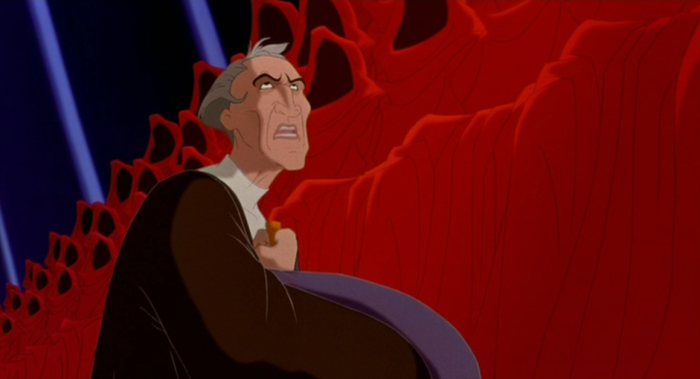
Best Song: “Hellfire”
When I say that The Hunchback of Notre Dame is my favorite Disney movie, I tend to get one of two reactions: "Are you kidding me?!" or "I've never seen it." Both of these are understandable for multiple reasons, especially if you know at all how the media reacted to the film in the '90s. But even through all of the parental judgment my mother got for letting me watch it, I still viewed Hunchback multiple times during the summer of 1996.I'm going to be perfectly honest: Hunchback is by no means a perfect movie. It features way too many pop culture-style jokes for my taste, and as I've grown older, these moments make me roll my eyes more than they make my laugh. But in this case, the positives outweigh the negatives, and I still own my VHS copy. But why do I have such a strong connection to this awkward adaptation of Victor Hugo's classic novel? With the opening sequence, Hunchback cinematically sets itself apart from much of its '90s animated competition. It begins its story with a unique narrative structure, in which Clopin (voiced by Paul Kandel) tells the story of the film to a group of children via puppetry. Rather using dialogue, we're given an incredible opening song (written by Alan Menken and Stephen Schwartz). It explains the motivations of the characters, while also setting a much more chilling tone for the complex relationship between Quasimodo, the title hunchback, and Judge Claude Frollo, the main antagonist.This is the moment when I knew Hunchback wasn't just any other Disney movie – it was my Disney movie. It wasn't focused on the struggles of a teenage princess, nor was it only about romance, but instead something bigger: the search for justice for those that haven't received it. And as someone who went through quite a few of her own personal hurdles as a kid, that message rang loud and clear.This is also how I felt about the characters. Never in a Disney movie had I experienced such complex, and downright adult, animated individuals. They all had their charms, their lows, and even their disgusting angles, but I always wanted to know more.
The wide-eyed and innocent Quasimodo is a character controlled by guilt, even more than Simba or other Disney protagonists that came before him. Esmeralda, though beautiful and strong, couldn't fix every obstacle that stood in her path. The sarcastic and hilarious Phoebus was still a battered hero with terrible pick-up lines. And Frollo, as calculated as he seemed, was really just a sexually frustrated individual who just couldn't deal with his impure thoughts. Maybe I was just a weird kid, but this crew seemed much more interesting than Ariel's friends and foes ever did.Sadly, people tend to only focus on Hunchback's hit-and-miss Gargoyle humor and the more violent elements of the story, but there's a reason why this movie has a following – it is bold and unafraid to be itself, much like its hero later becomes. It might be a sugarcoated retelling of the original novel, and it might not always hit every mark, but the movie is an odd and wondrous sight to behold. So what would Disney Animation release as their next full length feature? Well, let's just say it wasn't your typical story of royalty...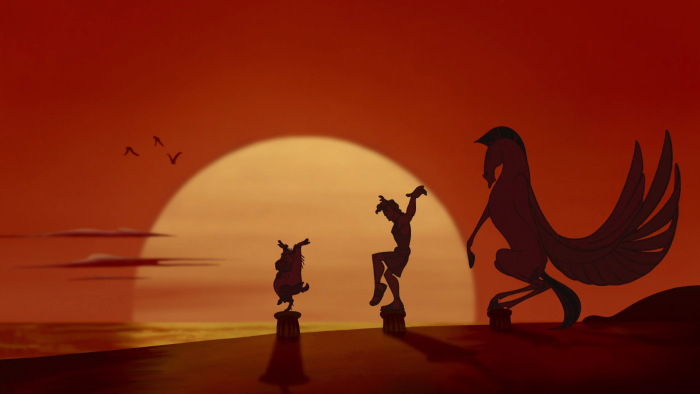
Best Song: “Go The Distance”
Directed by John Musker and Ron Clements, Hercules wears its flaws on its animated sleeve. The shades of their prior animated work (Aladdin) can be felt all over this particular project. Both are stories of young boys becoming heroic men, who are driven by wanting to find a place to belong, and are romantically attracted to strong ladies. Add in the funny Genie type character (Phil) and a mode of transportation with personality (Pegasus) and...well, I'm sure you get where I'm going with this. But that shouldn't deter from what makes Hercules something special all on its own. The production design, aided by British cartoonist Gerald Scarfe, is unique, and when you notice the influence of Al Hirschfeld blended into the character designs, you can't un-notice it (in a good way, of course). The music throughout (by you guessed it, Alan Menken) is also infectious, as it shifts from Gospel to '50s-inspired R&B in the blink of an eye. But with Menken in control of the music, it becomes a seamless experience.
Yet the true selling point of Hercules isn't the electric animation or the music, but the voice acting. From James Woods as Hades to Susan Egan's take on the screwball sass queen that is Megara, it's hard to chose a favorite. But I always go back to Tate Donovan's performance as the title character. He totally gets the goofball nature of Hercules, while also playing up his vulnerabilities, even when this hero is supposed to be at his most powerful. His line delivery (especially in his big speech at the end) always get me right in the "feels."Yet I'll admit that, at its core, Hercules is one of those movies that I love more out of nostalgia than anything else. Though I'm still sticking to my guns and will say that it does a lot right, it is sloppy as often as it is successful. Ultimately, I don't love Hercules any less for its shortcomings, but it just doesn't "go the distance" as it once did for me.The next Disney flick to come out also featured a tale of a great hero, but one that really changed the studio for the better.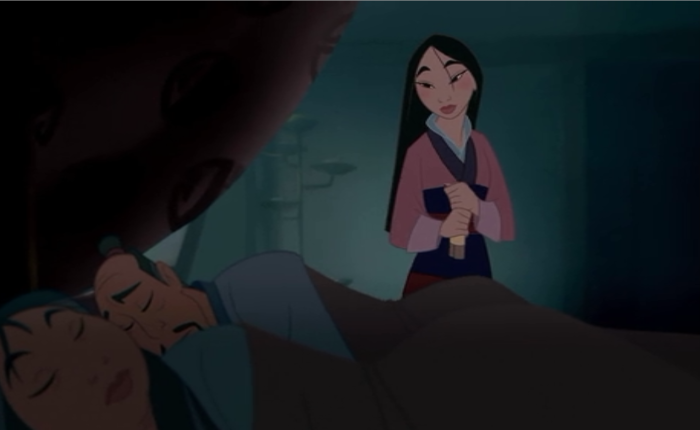
Best Song: “I’ll Make a Man Out of You”
Though many will cite Pocahontas as the first true kick-butt female character of Disney's Princess crew, I would say that Mulan deserves that honor. Yes, Mulan is obviously the pinnacle of girl power in the Disney cinematic world, paving the way for future ladies such as Kida from Atlantis and Moana. But does this all necessarily mean that Mulan (the movie) is as great as the achievements of her character?First, we have to give a look at the production design elements, which are on par with that of Hunchback and even the Lion King in terms of scale and scope. Even watching the teaser trailer (featuring unfinished rough animation), you knew that, artistically, this was a Disney movie unlike any other they had made before. With the Chinese influences inspiring the design, songs, and characters, this wasn't your grandma's Mickey Mouse cartoon.The cast of characters are also exceptional. Take our leading lady, who begins the story as a girl who doubts the role that society wants her to take on, makes a sacrifice for her family, and eventually becomes the person that she was destined to be all along. She (along with the other "good guy" characters) might be flawed and take their time to learn their lessons (especially Mushu and Li Shang) but that's what makes them such a joy to watch. We adore them when they sing about their worries, cheer when they win, and celebrate their imperfections.
Speaking of laughter, let's discuss Mulan's humor. There's a reason why so many people continuously use gifs and memes inspired by this movie almost 20 years later. We've all been at an event like summer camp or a convention that feels like Mulan's moments in the army. Some of us have had inspirational friends like Mushu. And though there are times where the pop culture gags slow down the story rather than progress it (like the Batman reference near the end), the majority of the jokes stick the landing.If there was an area where the film simply doesn't work, it would be the villain. Yes, you could say that some of the things we don't see on camera make for some of the most disturbing acts of villiany in a Disney film, but that is the major issue. If we saw more of the spooky aspects of the Huns rather than just hearing about it, they would remain as a threat in our minds. Instead, the snowy mountains in which Mulan battles on come off much more threatening than the bad guy himself.But by the end of its running time, once you push away the forgettable villain, awkward ancestral meetings, and some of the less important subplots, it is easy to see that Mulan is quite the Disney gem. It serves as a great reminder of what the animation team could achieve artistically in the late '90s, and that they could still produce something spectacular several years after The Lion King. Plus, any movie that has "I'll Make a Man Out Of You" on the soundtrack is bound to be a classic.Unfortunately, the same can't be said for what would come next.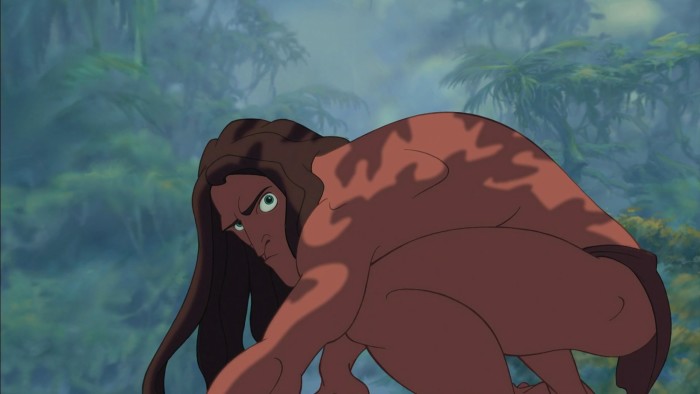
Best Song: “Strangers Like Me”
My first memory of Tarzan (other than reading the original books) relates to my childhood drawings. At age 9, I was convinced that I had the artistic skills to properly produce a shirtless, loin cloth-wearing ape man on paper. Fast forward to me later getting called into the principal's office for rendering what my teachers thought was a naked woman. And honestly, that pretty much sums up my entire relationship with this movie. As much as I adore the world of Edgar Rice Burroughs' stories, Disney's Tarzan never really captures what makes the character special.Beginning with an intense shipwreck and the pop vocals of Phil Collins, Tarzan starts off strong. Without any narration, we get the origins of our hero and his ape family. But once the story is established, things go down a strange path.I get that this is Disney, but sometimes comedic elements (with Tarzan's friends and Jane's father) just draw too much attention from the dramatic elements of the story. The climatic building blocks of Tarzan's relationship with his ape parents, and with Jane, are what really sell the emotional components of the movie. So when too much of the focus is on the comedy, those aspects of the plot feel thin when they should be the driving force of the movie.Then there's Clayton, a bad guy who is just too Gaston, too Radcliffe, and too McLeach to be memorable. He sticks out among the other characters as the most underdeveloped, armed with only the typical been-there-done-that motivations of greed and supremacy. And when you look at the other villain Tarzan gives us, Clayton is especially lacking when compared to leopard baddie, Sabor. If only the creative team had realized how much more Shere Khan levels of scary this character could have been, then maybe Tarzan's climatic finale would have felt that much more satisfying. But the thing people always like to gripe about with Tarzan is the music. This is the first Disney movie (since The Rescuers Down Under) to have non-traditional musical sequences. The soundtrack complements the scenes, but none of the characters (except Trek) are diegetically producing the tunes. Instead, the songs are more supposed to act as a voice to Tarzan's feelings. And though Phil Collins does give some great and catchy melodies, they just don't live up to the legacy that '90s Disney (and mostly Alan Menken) had paved.
What Have We Learned?
Through looking at Disney's late '90s catalog, it is quite clear that the animators were thinking outside the box. They were willing to take a leap of faith, even if the results weren't always as "Zip-a-Dee-Doo-Dah" as they had hoped. And though those artistic risks might not have resulted in the kind of Oscar or box office success as the earlier renaissance titles, they have their own fair share of victories.We met diverse and complex protagonists, who were all beautiful and strange in their own ways. We encountered some great villains (while others could have been defeated with a simple poke). We laughed, we cried, and we sang our hearts out. These movies may not be undisputed classics, but they occupy a special corner of the Disney canon. Ignore them at your own peril.
